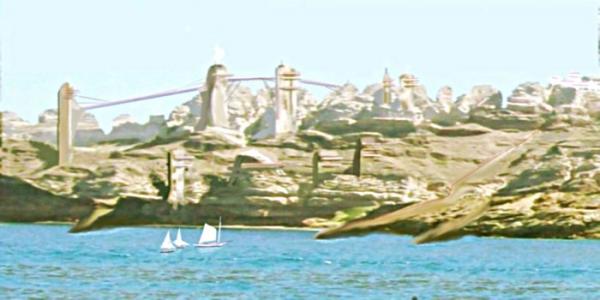BY LETTER
Reef, Reef-city
Technology > Application > Agriculture
Technology > Technology Type or Material > Gengineering
Technology > Technology Levels > High Tech / Hitech
Technology > Application > Infrastructure
Technology > Technology Type or Material > Organic/Biotech
Technology > Technology Type or Material > Gengineering
Technology > Technology Levels > High Tech / Hitech
Technology > Application > Infrastructure
Technology > Technology Type or Material > Organic/Biotech
Colloquial term for large gengineered arcologies often found on bioist worlds and habitats, particularly in the Biopolity. | |
 Image from Steve Bowers | |
| A reef-grown city, consisting almost entirely of coralline aragonite produced by gengineered anthozoans, plasms and biobots | |
A fully grown Reef operates as a living city for its inhabitants, providing for all of their needs and desires as a side effect of its own life processes. Living space, food, water, transport, and data and communications support are all provided by various systems produced by the Reef or by organisms living symbiotically within it (in many cases, the inhabitants themselves may live in symbiotic union with the Reef, their biological waste products feeding or otherwise helping to sustain it).
Reefs may be constructed using plasm based systems, gengineered organisms, biobots (see Buildbug) or some combination of all three. In general they are constructed (grown) in the shallow coastal waters of terraformed planets or large habitats and are built up from materials extracted from the water and sea floor.
Smaller Reefs may be grown entirely from natural biological materials and are mostly submerged, providing homes for aquatic or amphibious sophonts of various sorts. Larger Reefs may extend hundreds of meters above (and below) the surface and usually employ a combination of natural materials and gengineered forms that have been modified to incorporate carbon nanofiber, diamondoid, and various metals for extra strength, durability, electrical conductance, or other desired properties. These larger habitation structures often support populations of millions of different sophonts, each type of being occupying a portion of the reef that suits it best, with the reef itself modifying its local structure to better accommodate its inhabitants.
Related Articles
- Biocity - Text by M. Alan Kazlev and Stephen Inniss
A city or urban area created and maintained primarily through biotech ("wet" tech) methods and materials, and consisting of living organisms or their products (bone, wood, coral, shell, and so on) as opposed to one constructed using non-living "dry" tech and associated materials such as concrete, steel, glass, stone, diamondoid, or corundumoid.
Appears in Topics
Development Notes
Text by Todd Drashner
Initially published on 28 December 2007.
Initially published on 28 December 2007.






